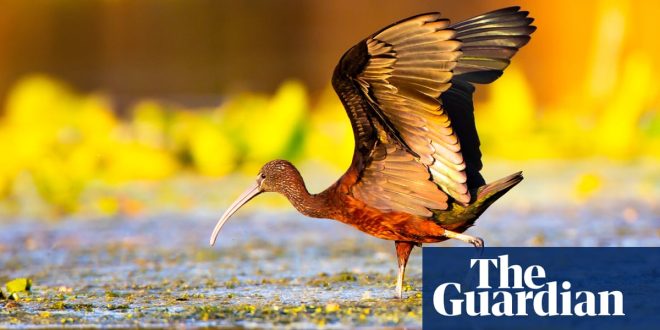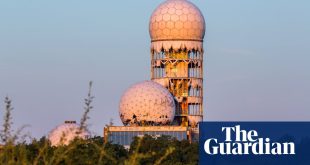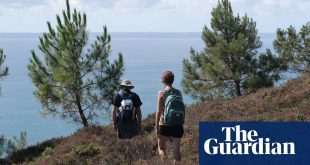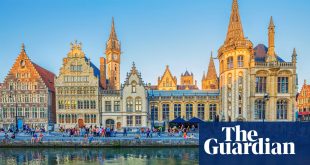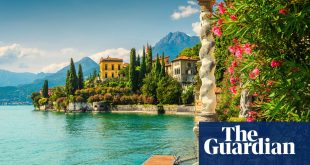The synthetic-sounding call of a lone bird rises notably above a riot of birdsong. On the horizon, a purplish sunset is reflected in the vast waters of Europe’s largest wetland. “It’s like another world,” says Charlie Ottley, a British documentary maker who has presented two Netflix documentary series on Romania. “It’s one of the most biodiverse places in the world, not just in Europe.”
This moment on the top deck of the floating hotel my eight-year-old son Tommy and I are staying on marks the end of a long day in Romania’s Danube delta. This is where the Danube – which originates in Germany’s Black Forest and snakes through 10 countries – empties into the Black Sea. “This is the Amazon of Europe,” Ottley says, gesturing to the sprawling maze of reed beds, canals, floating islands, marshes, lakes and forests.
I have lived in Romania for nearly 10 years yet never explored the Danube delta. What I discover feels like a country within a country, a wilderness so unspoilt and expansive as to match or surpass the better-known Carpathian mountains for its rich wildlife and culture.
We’re part of a dozen-strong group on a tour of the wetland wilderness led by guide Daniel Petrescu, who has a deep knowledge of this Unesco-stamped nature reservation and a knack for imitating bird calls.
Our open-deck viewing boat departs from Tulcea, the gateway city to the delta close to the Ukrainian border, and slowly moves through the Trofilca Canal, where 20 breeding pairs of kingfisher have burrowed nests into the earth banks. Ottley calls this “kingfisher alley”. We watch as dozens of brilliant blue flashes dart about us, turning the narrow canal into a fairytale scene.
Home to more than 300 migratory and resident bird species, including white and Dalmatian pelicans, purple herons, white-tailed eagles, pygmy cormorants, glossy ibises and red-breasted geese, the Danube delta is for nature lovers and bird watchers what the Olympics is to sports fans. It’s also an important breeding place for migratory birds .
“If you’re into wildlife and birding, the Danube delta is an absolute must,” Ottley says. “People also come here when they want a spiritual break. It really feels like you’re leaving civilisation behind.”
We emerge into a lake where hundreds of white pelicans are feeding. I borrow Petrescu’s binoculars and zoom in on the scene. They appear comically cartoonish up close, guzzling their catch with their enormous, spoon-like bills.
Our three-day trip was organised by Ottley, who has become, through his documentaries on Romania, a sort of ambassador for the country. The floating hotel has 10 comfortable en suite bedrooms and a team of cooks, and is almost entirely powered by solar energy. There are panoramic views from the windows in the central dining area. While the viewing boat navigates the wetland, a small tug tows the floating hotel to picturesque spots for when the guests return.
We spend our first night moored in Tulcea before heading into the delta proper. As we travel, Tommy and I feel as though we have been cast in a David Attenborough documentary.
There is lots to see and do, but it’s not a place to race around. “A lot of people come here in a speedboat and zoom around disturbing the birds and their nests,” says Ottley. “They don’t really see very much.”
On our first full day, we sit on the slow-moving viewing boat marvelling at our tranquil surroundings as we meander through narrow channels and open lakes. Afterwards, we return to our floating hotel for a dinner of local cuisine: catfish soup, then zander (or pikeperch) with potatoes and the pungent garlic sauce called mujdei.
From the top deck, we watch a majestic white-tailed eagle, several black-throated loons and some of the thousands of pairs of white pelicans that return from Africa each spring to breed here.
As well as wildlife, the delta’s history and communities are also fascinating. The region is home to Lipovans, ethnic Russians who moved to Romania several centuries ago after they broke from the Russian Orthodox Church. Olympic gold-medal-winning canoeist Ivan Patzaichin, who died in 2021, was inspired to take up the sport by other successful canoeists from his small delta village, Crișan.
after newsletter promotion
“He was committed to promoting the Danube delta but in particular slow tourism,” Ottley says of his late friend.
In the 19th century, Sir Charles Hartley, a British engineer described by contemporaries as the Father of the Danube, played a key role in transforming the Sulina channel into the trade route it remains today.
As the sun sets, we alight at a secluded beach near the Black Sea port town of Sulina. The sea is a teeth-chattering 14C, but Tommy, having spotted half a dozen bright green tree frogs, persuades me to join him for an invigorating dip.
Later, we head back upstream to the town’s Perla restaurant for the standout culinary experience of the trip: pike caviar with fresh bread, lemon and onion, then bowls of Japanese sea snails (an invasive species that thrive in the Black Sea) in a rich garlic and chilli sauce. “You’re doing a favour to the ecosystem by eating them,” Ottley says.
Our floating hotel has moored for the night in isolated marshland. “It is practically pristine, because there is no human intervention in this area,” says Petrescu. “The big surprise is the grandeur of the place – you never get the scale of it until you come here.”
On our last full day in the delta, we head for several hours through lakes and channels to Letea, a subtropical forest known for its wild horses, rare plants and insects, and gently undulating sand dunes. The galloping horses look spectacular, but they do threaten the area’s delicate ecosystem.
We take a bumpy horse and cart ride across pastures to where the forest is fenced off to protect it. “These are beautiful and majestic animals and everybody loves to see horses run and be wild,” says Petrescu, who was born in Letea. “But too many of them in such a unique place is not good.”
After lunch in the courtyard of a traditional thatched-roof dwelling in Letea, we stroll through the village. Many homes lie abandoned in a community decimated by economic migration. But things may be improving. “Today tourism is important to village life,” Petrescu says. “It’s not easy to live in a place as isolated as this.”
At 5am on our last morning, I peer out of the window. The sun is rising as our hotel passes thick reed beds on its return to Tulcea, and I head up to the top deck to watch the light spread.
Hours later, as we approach Tulcea, with its skyline of communist-era blocks, I remark to Ottley that it feels strange to return to civilisation. “You can just get completely lost in this world,” he says. “It transports you in a really incredible way.”
The trip was provided by Ibis Tours, which runs six-night trips on the floating hotel from €800pp, including all meals, transfers and experiences
 Top Naija News – Nigeria News, Nigerian News & Top Stories Top Naija News – Nigerian Newspapers, Nigerian News. topnaijanews is a daily Nigerian newspaper covering Latest News, Breaking News, Entertainment, Sports, Lifestyle and Politics.
Top Naija News – Nigeria News, Nigerian News & Top Stories Top Naija News – Nigerian Newspapers, Nigerian News. topnaijanews is a daily Nigerian newspaper covering Latest News, Breaking News, Entertainment, Sports, Lifestyle and Politics.
